America may drink more vodka than any other spirit, but it is very much a whiskey-loving country. Some of the most recognizable brands from the States carry the name of our whiskey-making forefathers, like Jack, Jim, and Evan. Bourbon is the country’s Congress-approved official spirit. And while Kentucky and Tennessee get most of the attention, there are all kinds of interesting whiskey made across the entire US.
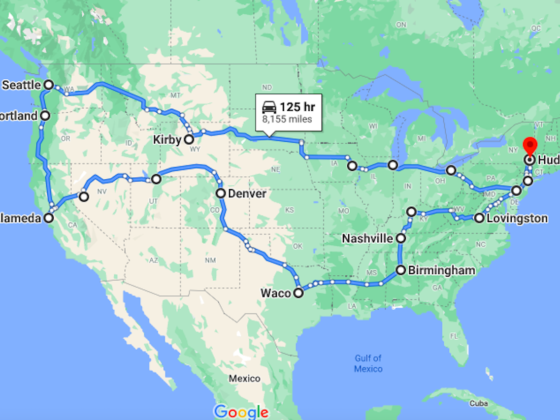

The Ultimate American Whiskey Road Trip, Mapped
Which brings us to the ultimate American whiskey road trip. It starts in New York, heads south through Texas, and then west to California before taking a trip back east on a northern route. Even this 20-stop trip won’t cover all of the great whiskey being made stateside, but it’s a great start. Here’s how to plan the most extravagant, coast-to-coast whiskey road trip.
Editor’s note: While some places are starting to open back up, most distilleries remain closed or aren’t offering tours. We suggest you plan now, travel later.
New York
In 2015, distillers from Black Button Distilling, Coppersea Distilling, Finger Lakes Distilling, Kings County Distillery, New York Distilling, and Tuthilltown Spirits created a new whiskey designation called Empire Rye. It’s a reference to New York’s importance in rye whiskey production prior to Prohibition. These distilleries (Van Brundt joined later) all make a whiskey from start to finish in New York using at least 75 percent New York-grown rye grain. The result is a delicious class of whiskeys that can compete with the best. These distilleries are ample reason enough to start with New York on any whiskey-focused road trip.
Where to go: Hudson is a good home base to dive into Empire Rye, though city lovers may prefer to start in the Big Apple. You can find many of the distilleries in the Hudson Valley (including Tuthilltown, Hillrock, and Coppersea), as well as in New York City (New York Distilling Company, Van Brundt, and Kings County Distilling).
Virginia
Near the 500-or-so-person town of Lovingston, Virginia, you’ll find Virginia Distillery Co. It started in 2011 and makes an American single malt as well as a line called Virginia-Highland Whisky that blends Virginia-made whiskey with Scotch whisky and ages it in barrels previously used by local breweries, cideries, and distilleries. The latter is unlike what you’ll find anywhere else in all the best ways. Virginia Distillery Co. also has an on-site museum where you can learn about the long history of distilling in Virginia, which is the original home of spirit-making in America — George Washington’s distillery in Mount Vernon was once the largest whiskey distillery in the country.
Where to go: Starting at Virginia Distillery Co. will give you a good sense of what the state’s whiskey scene is all about, but it’s far from alone. From Lovingston (or nearby Charlottesville), you can expand out to Catoctin Creek, in Purcellville, which makes an award-winning rye whiskey, as well as Smith Bowman in Fredericksburg, which is the oldest continuously operating distillery in Virginia and makes a well-loved bourbon.
Kentucky
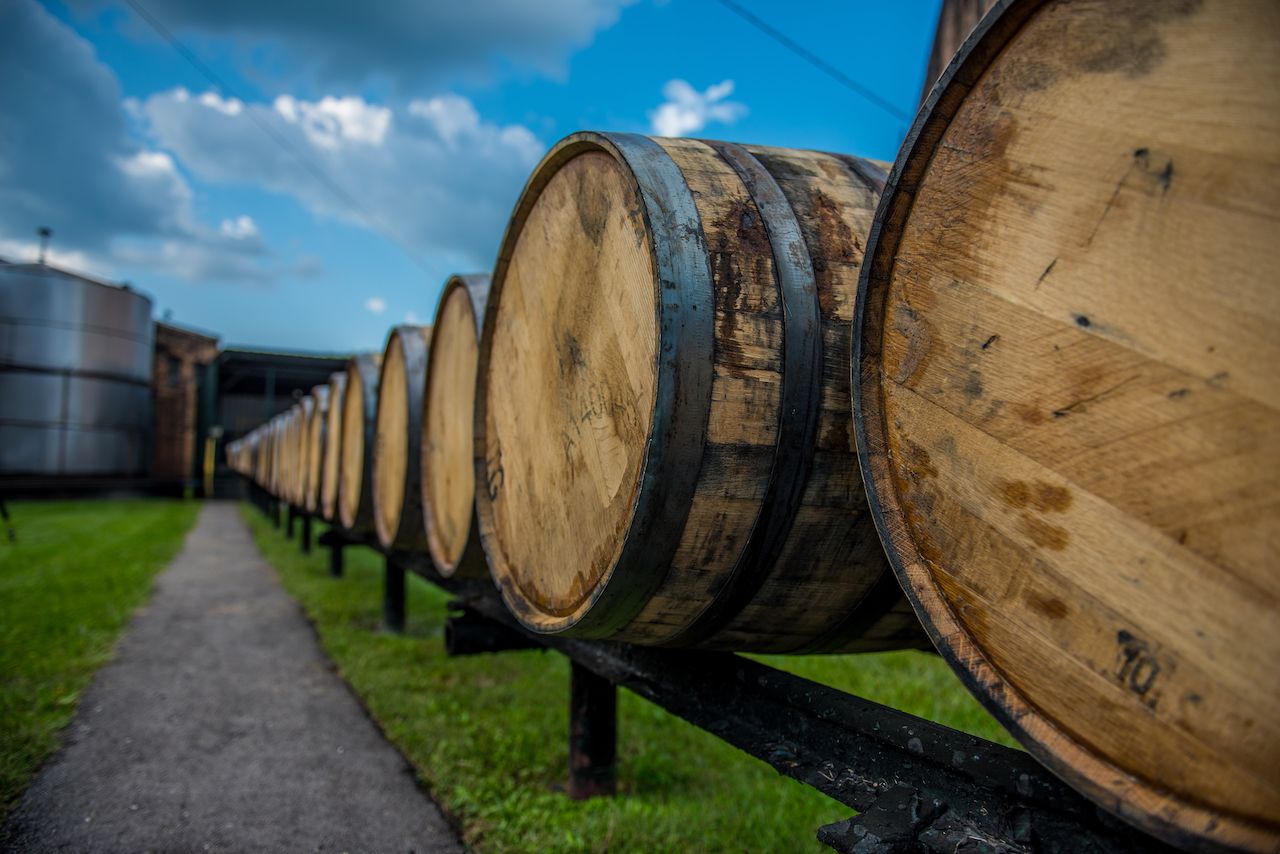
Photo: thomas carr/Shutterstock
Kentucky holds a special place in the hearts of American whiskey lovers. It’s the original home of bourbon, and there are many storied names in the industry. There’s frankly no American whiskey tour that would be complete without a good chunk of time spent in Kentucky. Distilleries can be found across the state, and there’s an official Kentucky bourbon trail to follow for the full experience (though there are also great distilleries to be found off of the bourbon trail, too).
Where to go: Start in Louisville, where you’ll find the historic Whiskey Row that was once the center of the city’s bourbon industry. Don’t miss the Old Forester distillery in the city, as well as Michter’s, Evan Williams, Stitzel-Weller, and get a taste of the new guard of Louisville bourbon at Kentucky Peerless. Make time to get out of Louisville, too, for excursions to Lawrenceburg for Four Roses, Versailles for Woodford Reserve, and Loretto for Maker’s Mark.
Tennessee
If Kentucky is the original home of American whiskey, Tennessee is its home away from home. Some of the largest, best-known distilleries can be found here, like Jack Daniel’s and George Dickel. There are many kinds of whiskey made in Tennessee. Perhaps the most distinctive are Tennessee-style whiskeys that follow the Lincoln County Process of charcoal mellowing. Along with the classics, a number of distilleries have popped up in Nashville and elsewhere over the past decade.
Where to go: Nashville is a fun place to center a Tennessee whiskey trip. Corsair, Nashville Craft, and Nelson’s Green Brier Distillery are all centered in the city. A trip to Lynchburg (which is infamously in a dry county) to see Jack Daniel’s is a must, as is a visit to the Uncle Nearest distillery in Shelbyville. Uncle Nearest comes from the history of Nathan “Nearest” Green, who was the first known Black master distiller and who taught Jack Daniel how to make whiskey. A trip to the Nearest Green Distillery is the best way to learn this history.
Alabama
Modern whiskey-making in Alabama has a pretty short history. The state enacted Prohibition in 1915 — five years earlier than the rest of the country. A legal whiskey wasn’t made in Alabama again until 2015 when John Emerald Distilling in Opelika released John’s Alabama Single Malt Whiskey. A stop here is a nice middle point between the Midwest bourbons of Kentucky and Tennessee and the whiskeys made to the west.
Where to go: Dread River in Birmingham for its Distiller’s Select Straight Whiskey, and if you have time for a little detour, over to Opelika for John Emerald Distilling.
Texas
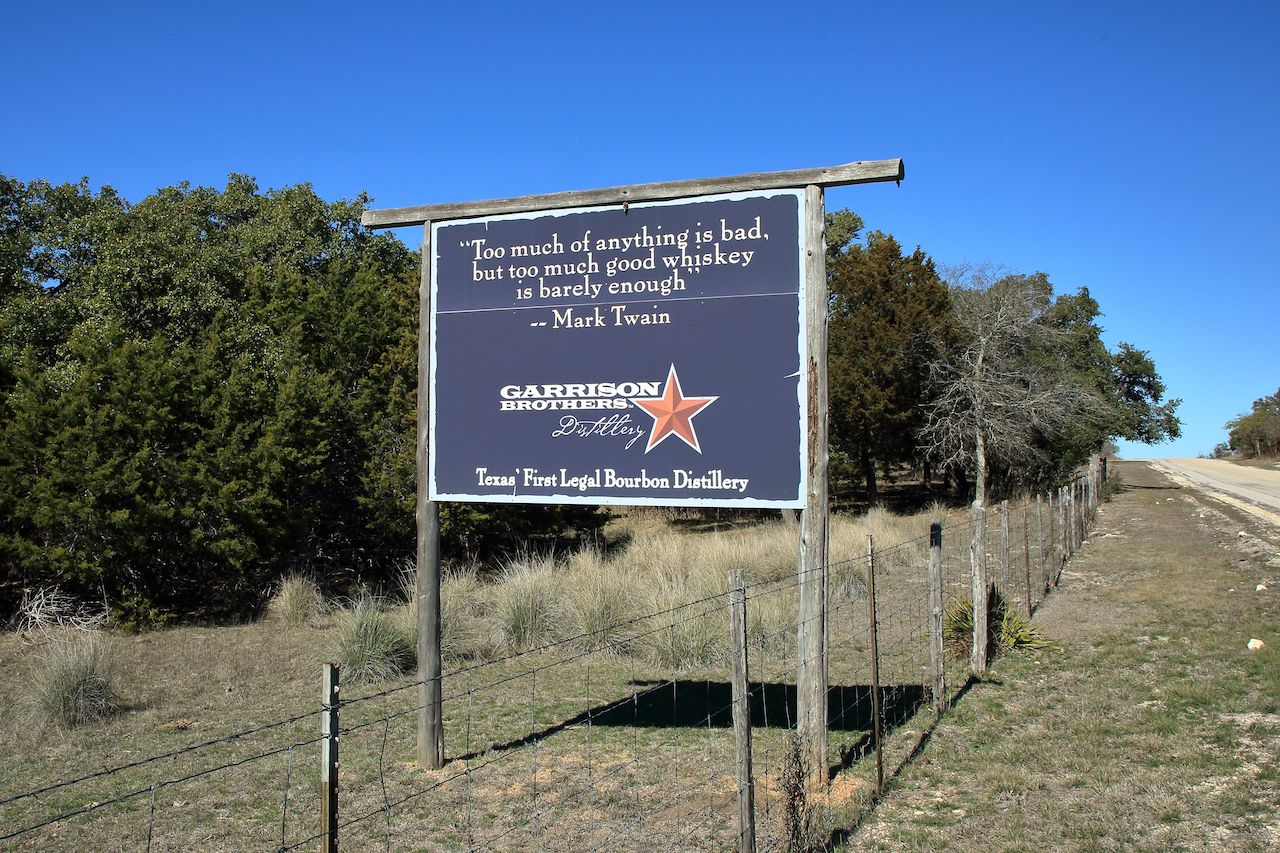
Photo: JustPixs/Shutterstock
In the 2000s, there were fewer than five distilleries making whiskey in Texas. Today there is an official Texas Whiskey Trail with more than 20 spots from San Antonio up to Dallas. Two of the early distilleries are still considered leaders: Balcones, which released the first Texas whiskey since Prohibition in 2009, and Garrison Brothers, which is the oldest Texas bourbon distilling license in 2006. Others have joined their ranks at an increasing pace over the past decade, including many that are making location-specific, grain-to-glass whiskeys.
Where to go: You probably already know that Texas is a big state. Start with Balcones in Waco and sip the Balcones Baby Blue Corn Whiskey. From there you can go north to Dallas and its first whiskey distilleries (Ironroot and Firestone and Robertson are popular options) or south to the nine distilleries in the Austin area (including Garrison Brothers in Texas Hill Country), four in Houston, and two in San Antonio.
Colorado
The Centennial State was one of the first to really foster a craft beer industry in the United States, and it’s more recently become just as much a leader in quality whiskey. Stranahan’s, which started in 2004, was the first small distillery to open in Colorado since Prohibition. Others have popped up in the Denver area and beyond. You’ll find whiskeys made exclusively with Colorado ingredients at Laws Whiskey House, a distillery with its own malting floor at Leopold Bros., and a bourbon producer that’s won fans across the country at Breckenridge Distillery.
Where to go: Denver is where many of the best Colorado distilleries are located. A trip to Stranahan’s should be on the list — especially if you can make it to one of the distillery’s release parties. Laws Whiskey House will give you a new appreciation for the effort (and tasty payoff) that it takes to make whiskey using grains from nearby farms. Others in Denver to make sure you visit to become familiar with Colorado whiskey include Leopold Bros., Ironton Distillery, and Bear Creek Distillery. And don’t forget State 38 Distilling in nearby Golden, while Breckenridge Distillery proves there’s more to do in the ski town than hit the slopes.
Utah
Utah doesn’t have the same reputation for craft spirits as its neighbor Colorado, but High West puts the state on the map for people who love good whiskey. High West opened in 2006 when it became the first legal whiskey distillery in Utah since 1870. The distillery made a name for itself by being hyper transparent about its blending practices. Many of its most famous bottlings are made up of a blend of whiskeys from the mega distiller MGP Ingredients as well as the distillery’s own product.
Where to go: The main location in Wanship is surrounded by the Wasatch-Uinta mountain range and is hard to beat in terms of whiskey with a view. In the winter, head a little farther south to High West’s Park City location. It’s at the bottom of a ski slope and is the world’s only ski-in micro-distillery.
Nevada
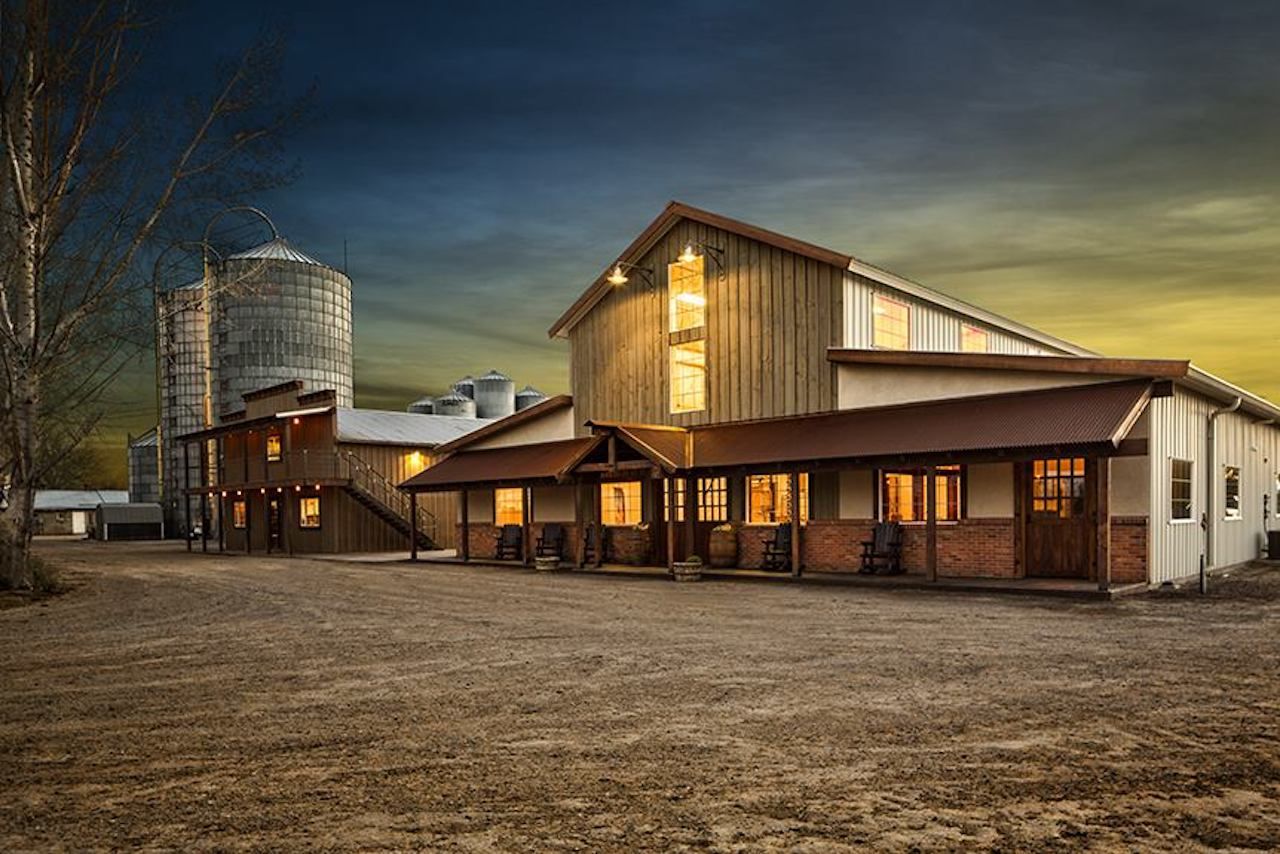
Photo: Frey Ranch Distillery/Facebook
Nevada is home to many vices, but a wealth of American whiskey distilleries isn’t one of them. Still, the state is worth a stop on any trip west for people interested in seeing where the craft whiskey movement is growing. Just don’t expect to center a whiskey-focused visit to the state in Las Vegas. The most notable whiskey distillery in Nevada is in Fallon, which is about six hours from Las Vegas and an hour from Reno.
Where to go: Frey Ranch is the number one Nevada whiskey to see what farm-to-glass truly is. The specialty grains for the rye and bourbon are grown onsite, and the whiskey is distilled, aged, and bottled not far from the farm. If you’re looking for others in the state, there’s The Depot Craft Brewery Distillery in Reno and the Las Vegas Distillery in Henderson.
California
The state may be better known for wine than whiskey, but don’t write California off when it comes to hard spirits. One of California’s most famous distilleries, St. George Spirits, puts a California spin on Kentucky and Tennessee whiskeys by blending them with the distillery’s malt whiskey. A number of other distilleries make quality whiskey using all California ingredients. A stop in Northern California is an ideal start to seeing the West Coast’s whiskey scene.
Where to go: Start at St. George Spirits in Alameda and then head north to wine country where you’ll find Charbay’s beer-centric whiskey in St. Helena, Griffo Distillery’s bourbon in Petaluma, and whiskey aged in wine barrels at Graton Distilling Company in Graton.
Oregon
The Pacific Northwest is where you’ll find two of the most exciting American single malt whiskeys: Westward, in Portland, and Westland, in Seattle (more on that later). People in Oregon were early to the craft whiskey boom, as to be expected in such a drinks-loving state. Westward opened in 2004, and a number of others can be found along Portland’s Distillery Row.
Where to go: Start at Westward to sip on definition-setting American single malts as well as expressions aged in casks previously used for pinot noir or stout beer. Rolling River Spirits and New Deal Distillery on Distillery Row also offer whiskeys. McCarthy’s is just outside of Portland in Clear Creek, and a trip to Oregon wouldn’t be complete without a visit to Rogue Ales and Spirits in Newport.
Washington

Photo: Westland Distillery
/Facebook
Continue north into Washington to complete the West Coast portion of the trip. Washington, like Oregon, is known for craft beverages of all kinds — it has the third most distilleries by state after California and New York. Whiskey is one major highlight. There’s Westland, which is one of the leaders in the new American single malt category; Dry Fly, which released the state’s first bourbon in 2007; and Bainbridge, which makes whiskey using 100 percent organic Washington wheat.
Where to go: Many of the best distilleries are centered in and around Seattle, including Westland (be sure to try the Native Oak series), Copperworks, Oola, Batch 206, and Bainbridge. On your way back east, be sure to stop by Dry Fly in Spokane.
Wyoming
A brief stop in Wyoming is necessary to complete the full cross-country loop. The state isn’t a hotbed for whiskey distilling compared to the West Coast states, but it, too, has had something of a brewing and distilling renaissance over the past decade.
Where to go: Wyoming Whiskey is the most famous in the state, and it has earned top praise from publications like Esquire, Whisky Magazine, and more. Another distillery in the state to pay attention to is Pine Bluffs Distilling. It makes rye, bourbon, and oat whiskeys using Wyoming grains, and its location near the Colorado border makes it easy to pop in after a visit to Wyoming’s neighbor to the south.
Iowa
Iowa produces the most corn in the United States. So it may come as a surprise that the state didn’t have a home-grown bourbon until 2010 when Cedar Ridge released the first since Prohibition. Today, Cedar Ridge uses corn grown on the family farm in Winthrop, and it’s put Iowa whiskey on the map with multiple awards for its rye, bourbon, and wheat whiskeys.
Where to go: Cedar Ridge in Swisher is the heart of Iowa whiskey distilling. There’s a wide range of whiskeys, all of which are worth a taste (there’s also wine made onsite). Other whiskey made in the state includes offerings from Mississippi River Distilling in Le Clare, Iowa Legendary in Carroll, Artisan Grain in Davenport, and 3-Oaks Distillery in Holy Cross.
Illinois
Chicago was notorious for its continued whiskey importation and consumption during Prohibition. Oh how the times have changed. Today, whiskey made in the city and in Illinois in general is far better than what the ragers of the Roaring ‘20s were drinking.
Where to go: KOVAL makes a line of single barrel rye, bourbon, and oat whiskeys that are some of the best in Chicago. You can find beer-inspired single malt at Maplewood Brewery & Distillery, and FEW Spirits makes bourbons and ryes that are popular across the country. Chicago Distilling Company makes a range of spirits using Illinois grains, including a single malt whiskey, and has a tasting room for specialty cocktails.
Ohio
Like Alabama, Ohio was late to legalizing craft spirits and distilling. The state is quickly catching up on lost time thanks to a few innovative distillers, however. Some of the best homegrown whiskey in the state is made in Columbus, and the whiskeys can be found all over the Buckeye state.
Where to go: Middle West Spirits in Columbus makes six small batch whiskeys, including a wheat, straight rye, and bourbon. Also in Columbus, Watershed makes a bourbon along with lots of good non-whiskey spirits like a black walnut liqueur and a brandy made with Ohio apples.
Pennsylvania
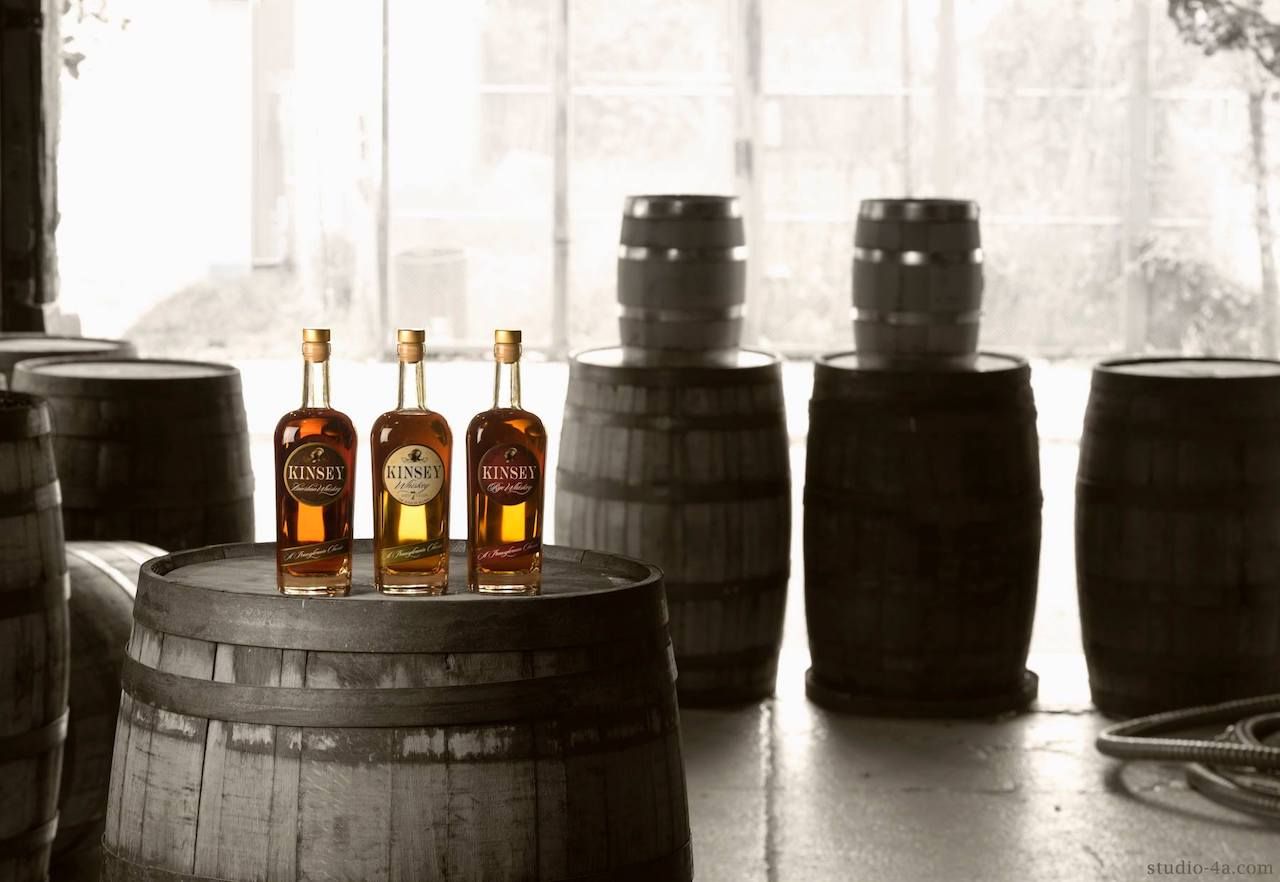
Photo: New Liberty Distillery/Facebook
Pennsylvania was one of the leading whiskey-producing states in the early days of the country. Prohibition changed that, and it wasn’t until 2011 that distilling laws opened up enough to create a second boom in Pennsylvania spirits. Philadelphia is a great place to see this for yourself. You can experience the full scope of what the region has to offer by following the Philadelphia Distillery Trail.
Where to go: Philly’s New Liberty Distillery is housed in an early 1900s horse stable, which is fun, but the real draw is the award-winning whiskeys. Red Brick Craft Distillery makes small-batch whiskey and rum, while Hewn Spirits in Pipersville makes whiskeys from local grains that are aged in reclaimed rare-wood barrels.